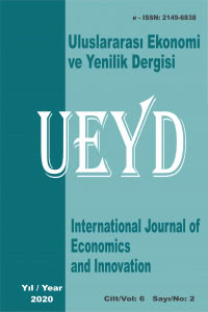Türkiye’de Gelir Dağılımı, Sağlık Harcamaları ve Yaşam Beklentisi İlişkisi: ARDL Sınır Testi Analizi
Bu çalışma, Türkiye’de gelir dağılımı ve sağlık harcamalarının doğumda yaşam beklentisi üzerindeki etkilerini 1987-2016 dönemi için gecikmesi dağıtılmış otoregresif (ARDL) modeli ile araştırmaktadır. Elde edilen sonuçlara göre gelir dağılımında adaletsizlik arttıkça doğumda yaşam beklentisi negatif yönde etkilenmektedir. Öte yandan toplam sağlık harcamalarının milli gelir içindeki payının artması ile yaşam beklentisi arasında anlamlı bir ilişkiye bulunmamaktadır. Ayrıca kişi başına gelir ve her 1000 kişi başına doktor sayısının artması, yaşam beklentisini pozitif yönde etkilemektedir.
Anahtar Kelimeler:
Gelir eşitsizliği, yaşam beklentisi
Income Distribution, Health Expenditure and Life Expectancy Nexus in Turkey: ARDL Bounds Testing Analysis
This study investigates the effects of income distribution and health expenditure on life expectancy at birth in Turkey for the period 1987-2016 by using the autoregressive distributed lag (ARDL) bounds test approach to cointegration. According to results, rising income inequality effects life expectancy negatively. On the other hand, no significant relationship exists between health expenditure share of GDP and life expectancy. In addition, per capita income and number of physicians per 1000 people have positive impact on life expectancy.
Keywords:
Income inequality, life expectancy,
___
- Barlow, R. ve Vissandjee, B. (1999). Determinants of national life expectancy. Canadian Journal of Development Studies/Revue canadienne d'études du développement, 20(1), 9-29.
- Brown, R. L., Durbin, J. ve Evans, J. M. (1975). Techniques for testing the constancy of regression relationships over time. Journal of the Royal Statistical Society: Series B (Methodological), 37(2), 149-163.
- Çelik, Y. (2011). Türkiye sağlık harcamalarının analizi ve sağlık harcama düzeyinin uygunluğunun değerlendirilmesi. SGD-Sosyal Güvenlik Dergisi, 1(1), 62-81.
- Deaton, A. (2003). Health, inequality, and economic development. Journal of economic literature, 41(1), 113-158.
- Engle, R. F. ve Granger, C. W. (1987). Co-integration and error correction: representation, estimation, and testing. Econometrica: journal of the Econometric Society, 55(2), 251-276.
- Johansen, S. ve Juselius, K. (1990). Maximum likelihood estimation and inference on cointegration—with applications to the demand for money. Oxford Bulletin of Economics and statistics, 52(2), 169-210.
- Judge, K. (1995). Income distribution and life expectancy: a critical appraisal. Bmj, 311(7015), 1282-1285.
- Kabir, M. (2008). Determinants of life expectancy in developing countries. The journal of Developing areas, 185-204.
- Kalediene, R. ve Petrauskiene, J. (2000). Regional life expectancy patterns in Lithuania. The European Journal of Public Health, 10(2), 101-104.
- Kawachi, I., Kennedy, B. P., Lochner, K. ve Prothrow-Stith, D. (1997). Social capital, income inequality, and mortality. American journal of public health, 87(9), 1491-1498.
- Kwiatkowski, D., Phillips, P. C., Schmidt, P. ve Shin, Y. (1992). Testing the null hypothesis of stationarity against the alternative of a unit root: How sure are we that economic time series have a unit root?. Journal of econometrics, 54(1-3), 159-178.
- Messias, E. (2003). Income inequality, illiteracy rate, and life expectancy in Brazil. American Journal of Public Health, 93(8), 1294-1296.
- Newey, W. K. ve West, K. D. (1994). Automatic lag selection in covariance matrix estimation. The Review of Economic Studies, 61(4), 631-653.
- Nixon, J. ve Ulmann, P. (2006). The relationship between health care expenditure and health outcomes. The European Journal of Health Economics, 7(1), 7-18.
- Or, Z. (2000). Determinants of health outcomes in industrialized countries: a pooled, cross-country, time-series analysis. OECD Economic Studies, 53-78.
- Pesaran, M. H. ve Shin, Y. (1998). An autoregressive distributed-lag modelling approach to cointegration analysis. Econometric Society Monographs, 31, 371-413.
- Pesaran, M. H., Shin, Y. ve Smith, R. J. (2001). Bounds testing approaches to the analysis of level relationships. Journal of applied econometrics, 16(3), 289-326.
- Preston, S. H. (1975). The changing relation between mortality and level of economic development. Population studies, 29(2), 231-248.
- Rodgers, G. B. (1979). Income and inequality as determinants of mortality: an international cross-section analysis. Population studies, 33(2), 343-351.
- Saunders, P. (1996). Poverty, income distribution and health: an Australian study (Vol. 128). University of New South Wales.
- Shin, Y. ve Schmidt, P. (1992). The KPSS stationarity test as a unit root test. Economics Letters, 38(4), 387-392.
- Solt, F. 2019. Measuring Income Inequality Across Countries and Over Time: The Standardized World Income Inequality Database. SWIID Version 8.1, May 2019.
- Şahin, D. (2018). Doğumda Yaşam Beklentisinin Belirleyicilerinin Analizi: APEC Ülkeleri Örneği. Ömer Halisdemir Üniversitesi İktisadi ve İdari Bilimler Fakültesi Dergisi, 11(1), 1-7.
- Tüylüoğlu, Ş. ve Tekin, M. (2009). Gelir Düzeyi ve Sağlık Harcamalarının Beklenen Yaşam Süresi ve Bebek Ölüm Oranı Üzerindeki Etkileri. Çukurova Üniversitesi İktisadi ve İdari Bilimler Fakültesi Dergisi, 13(1), 1-31.
- Wilkinson, R. G. (1992). Income distribution and life expectancy. BMJ: British Medical Journal, 304(6820), 165.
- Wilkinson, R. G. (1992). National mortality rates: the impact of inequality?. American Journal of Public Health, 82(8), 1082-1084.
- ISSN: 2149-6838
- Yayın Aralığı: Yılda 2 Sayı
- Başlangıç: 2015
- Yayıncı: Seyfettin Artan
Sayıdaki Diğer Makaleler
Türkiye’de Bölgesel Enflasyon Yakınsaması: Panel Birim Kök Testlerinden Kanıtlar
Selcen SARI AYTEKİN, Elif SİS ATABAY, Tarhan OKAN, Erdoğdu Sabri AYTEKİN
Entegre Raporlama ile ilgili Yapılan Çalışmalar: Literatür Taraması
Mahmut ÇELEBİER, Prof. Dr. Fikret ÇANKAYA
Selcen SARI AYTEKİN, Elif SİS ATABAY, TARHAN OKAN, Erdoğdu Sabri AYTEKİN
Özlem AKAY, Cahit ÇELİK, Gülsen KIRAL
Türkiye Ekonomisi Cari Açığı Sürdürülebilir Mi? Birim Kök Testleriyle Bir İnceleme
An Empirical Investigation of Bubble in the Turkish Stock Market
Enerji Tüketimi ve Ekonomik Büyüme İlişkisi: Panel Eşanlı Model
